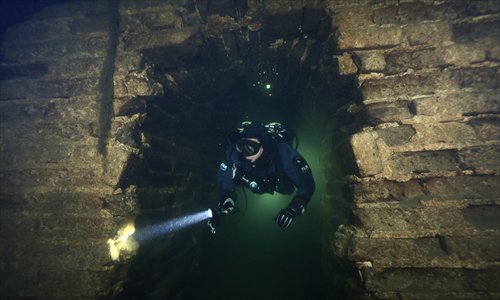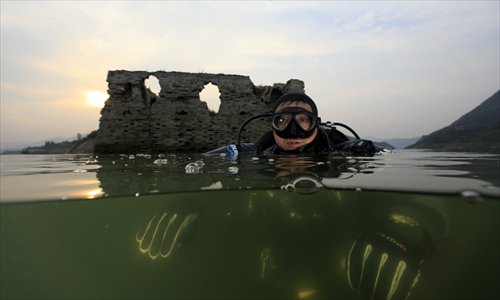Off-the-wall dive
Exploring history below the water’s surface

Diver Li Jiafan cruises through a gate on the Xifengkou section of the Great Wall at Panjiakou water reservoir in Hebei Province. Photo:Courtesy of Wu Lixin
As the cold water swirls around the torch light, shedding light on the majestic bricks, towering gates and collapsed relics of a bygone era, 45-year-old professional diver Li Jiafan holds his breath as an underwater miracle unfolds before him.
"It's the one and only," said Li.
The underwater section of the Great Wall, or the Xifengkou Great Wall, lies on the border between Tangshan and Chengde, both in Hebei Province, about 250 kilometers from Beijing's CBD (Central Business District).
Built more than 500 years ago with a length of about 50 kilometers and with 21 watchtowers along its path, this section of the Ming Dynasty (1368-1644) Wall served as an important gateway to the north. In 1975, the Panjiakou water reservoir was built to divert water from the Luanhe River to Tianjin and Tangshan. It submerged this section of the Wall, turning it into a unique diving spot for many. But the fluctuating water level of the reservoir leads to the Wall resurfacing from time to time.
As the old Chinese saying goes, "One who fails to reach the Great Wall is not a hero," and in the diving circle, every diver wants the chance to explore the underwater part of the Great Wall, too. "We've been to the South China Sea and many more appealing diving spots in China. And we've taken pictures of beautiful coral, fish and seaweed. But to be frank, you can find similar scenes in the waters of the Philippines or Malaysia," said Li. "However, there are no other diving sites in the world like the underwater Great Wall."


Li Jiafan is one of a few pioneer divers of the underwater Great Wall at Panjiakou water reservoir in Hebei Province. He advises only experienced divers with advanced equipment attempt to dive there. Photos: Courtesy of Wu Lixin
The one and only
In ancient times, the watchtowers served as places to store supplies for soldiers stationed there, and the reconnaissance of enemy movements. Now they mark the spectacular underwater scenery only accessible to a few people with advanced diving skills. At the parts where the Wall gradually disappears under water, divers can walk and dive along its surface to deep under water.
"When I went diving there, I thought about how a lot of people, carrying arrows or rifles, accomplished their historical mission there," said Li. "That's where the cultural value of diving the underwater Wall lies, echoing the purpose of the Great Wall to protect people from foreign invasion."
The area witnessed several fierce battles. One of these was during the War of Resistance against Japanese Aggression (1937-45), when the Chinese soldiers attempted a night attack to wrest back control on the battlefield. In the Ming Dynasty, Qi Jiguang (1528-88), a heroic general, fought against foreign invaders at this very spot, too.
Li has dived as deep as 55 meters, where the water was clearer than on the surface which contains plankton and other matter. Li said it was really cold, and the water temperature can drop to as low as 1 C in May.
Therefore, it's not an easy job for the average diving enthusiast, said Li. "It's dark and cold, and a diving beginner will not have fun there." But Li said diving at the underwater Wall is appealing to advanced divers both locally and abroad, due to its uniqueness as well as its historical and cultural significance.
Li once took a diver from the US there, and they encountered turbid water, which made it impossible for them to even see their own hands. "But he was still happy and willing to dive there for a few minutes and touch the Wall. Because he knew the Wall is the one and only, and the underwater Wall is the one and only," he said.
Experienced diving required
Guo Yong, an experienced diving instructor with the Beijing Dive Buddy club who holds a PADI (Professional Association of Diver Instructors) certificate, has found that overseas diving enthusiasts are especially interested in China's underwater Wall experience. Two weeks ago, he accompanied a 71-year-old American woman who especially came to Beijing to dive along the Wall.
"Although we were shivering from the cold, seeing the hills rising and swooping underwater and swimming through the watchtowers was so special and exciting," he said. Guo recalled his first visit to the Great Wall, which was an important moment for the Sichuan Province native, but it couldn't compare to when he saw the Wall through his diving mask.
However, both Guo and Li stress that the underwater Wall experience is far from an entertainment or leisure diving spot. Li doesn't advise inexperienced divers attempt to dive there.
With colder water temperatures and compromised visibility, the area requires higher standards of diving equipment and advanced skills, said Li. "As it is open water, there are also fishing nets and cruising tourist boats in the area, which pose threats to inexperienced divers, whose orientation and buoyancy control might be compromised by the tough conditions," he said.
Chen Li, course director of Big Blue SCUBA Diving International in Shanghai, has visited Qiandao Lake in Zhejiang Province a few times for its underwater city. However, diving at the underwater Wall was still a challenge for an experienced diver like himself, mostly due to the effort to get there, and a lack of supporting diving facilities in the area. This means the divers have to bring oxygen tanks and everything else they need all the way from Beijing.
"As a manmade lake, its visibility is poor and it has a thermocline (a layer of water in which temperature changes more rapidly with depth than in other layers)," he said. Chen suggests divers wear dry diving suits, which are much more expensive than regular wetsuits, and are typically used when the water temperature is lower than 15 C.
Chen advises any divers who would like to explore the underwater Wall to at least hold an Advanced Open Water Diver certificate acknowledged by PADI, and to have had at least 30 to 50 diving experiences. He also suggests going with local diving instructors, instead of alone, to ensure safety and to save time.
Preserving history
Since 2006, Li and his fellow diving partners have explored the Wall through multiple visits, reading old maps and building their own coordinate system, trying to locate the best diving spots in such a vast area.
Li proudly said that only a small number of people in the world have ever seen the magnificent underwater scenery of the Nanmen (south gate) diving spot.
It is one of the deepest underwater spots in the area, where the water temperature was 4 C when Li measured it during his last visit there in June. It's known as the most appealing yet most challenging spot among many underwater Wall divers. Li said it took him almost two years to finally find the place.
Li and his friends have also found the remains of a grand bridge that was demolished, with its piers and road signs still visible underwater, waiting to be discovered. The changing water level is the biggest threat to the Wall, since the waves caused by tour boats are eroding the Wall little by little. "We certainly hope this section can be identified as an important historical heritage site which will be protected."
According to a Xinhua News Agency report in May, the Xifengkou section of the Wall is severely damaged, with watchtowers falling apart and walls crumbling. The fluctuating water level and the Wall emerging and submerging are increasing erosion and weathering of the Wall. The State Administration of Cultural Heritage has authorized local authorities to initiate a protective renovation program which started this month.
"For us, diving is merely a means to our final destination. The cultural values and photographic documentation of the experience mean so much more," Li concluded.